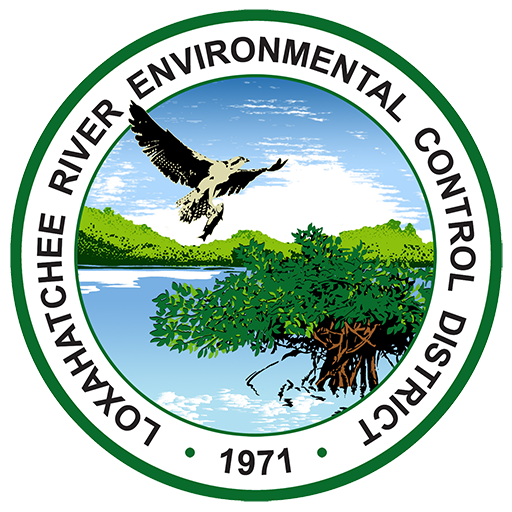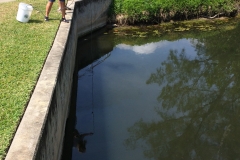About the Loxahatchee River
The Loxahatchee River Watershed has a wide variety of habitats and is home to many rare and endangered species, such as the manatee and woodstork. This 260 square mile ecosystem includes the communities of Jupiter, Tequesta, Juno Beach, Jupiter Island, Jupiter Inlet Colony, Jupiter Farms, Hobe Sound and Palm Beach Gardens. Learn more about the river.
WildPine Laboratory
To assist with research programs, the Loxahatchee River District has a state-certified laboratory which provides the needed scientific staff, equipment and professional analysis of daily plant operations, as well as an extensive river research program. Learn more about the WildPine Lab.
Water Quality
The Loxahatchee River District created Project RiverKeeper in 1973 to focus on water quality monitoring within the Loxahatchee River watershed. Data obtained through this program help water managers to evaluate and document the condition and ecological health of the river and to determine the location and extent of water quality issues that require attention.
- RiverKeeper– The Loxahatchee River District created Project RiverKeeper in 1973 to focus on water quality monitoring within the Loxahatchee River watershed.
- Water Quality Scorecard – Scores, maps, and tables of results
- Datasonde– Since 2004, the Loxahatchee River District has been using automated instrumentation (aka datasondes) to provide near continuous water quality data from key locations throughout the Loxahatchee River.
- Weekly Bacteria– The Loxahatchee River District collects and tests water quality samples for enterococci bacteria each week throughout Loxahatchee River estuary in popular recreation areas. This information is for you to use as a guide in deciding when and where to swim and recreate in the River.
- Jones Creek– Visit this page for more information on water quality monitoring and restoration efforts in Jones Creek, a tributary into the Loxahatchee River.
Minimum Flow and Level (MFL)
The South Florida Water Management District adopted the Minimum Flow and Level Rule that established minimum flow and salinity limits to prevent harm to the habitats in the Northwest Fork of the Loxahatchee River (Chapter 40E-8.221(4), F.A.C.). We have created an interactive tool to visualize the USGS and SFWMD river flow monitoring data measured at Lainhart Dam and salinity data from the USGS water quality station at River Mile 9.1. The tool also provides interactive plots of flow data from the SFWMD at the S-46 Flood Control Structure. Click HERE to access the Minimum Flow and Level (MFL) & S-46 Explorer Tool.
Rainfall
Rainfall affects river water quality when storm water flows transport pollutants into the river. Also, seasonal variations in rainfall drive river flow velocities that can significantly influence salinity patterns throughout the Loxahatchee River.
We have created a tool to explore temporal and spatial rainfall patterns over the Loxahatchee River watershed utilizing the South Florida Water Management District’s radar-based rainfall data named NEXRAD. To view a map of rainfall across the watershed, compare rainfall maps between two time periods, view tabular summaries of rainfall totals, and rainfall totals over drainage sub-basins click HERE to access the NEXRAD Explorer Tool.
Seagrass Mapping and Monitoring
Seagrasses play a critical role in providing sediment stabilization, nutrient cycling, food sources, and nursery grounds for many recreational and commercially important fisheries.
Oyster Restoration and Monitoring
Oyster reefs provide important benefits to the overall health of the Loxahatchee River by cleaning water, stabilizing shorelines and providing essential fish habitat. Oyster reefs have declined in the river due to a lack of hard surfaces where oyster larvae can attach. The Loxahatchee River District and their partners are working together to restore and conduct research on the oyster reefs in the Loxahatchee River.
Algae Monitoring
The term algae is used to describe aquatic photosynthetic organisms that can live in freshwater or marine environments. Algae can be visible to the naked eye growing on stream banks or ocean bottom (‘benthic algae’) or microscopic living in the water column (‘phytoplankton’). Small amounts of algae can be beneficial providing food and/or shelter to organisms. However, some algae can produce toxins that can have harmful effects to people and aquatic organisms. In high concentrations, other non-toxic algae can deplete oxygen in the water or smother seagrass and corals. Learn more about Algae.
River and Watershed Management
Loxahatchee River Management Coordinating Council (LRMCC)
The Loxahatchee River Management Coordinating Council was established by Chapter 83-358, Laws of Florida. The Council is comprised of federal, state, and regional agencies and local representatives. It advises the Florida Department of Environmental Protection and the South Florida Water Management District on matters that affect administration of the Loxahatchee River, to identify and resolve inter-governmental coordination problems and to enhance communications. The LRMCC website is: loxahatcheeriver.org/river/lrmcc/
The Council is responsible for the development of the Loxahatchee River Management Plan:
Loxahatchee River National Wild and Scenic River Management Plan
Recently, the Council worked with the Florida Department of Environmental Protection (FDEP) to develop the Loxahatchee River Pollutant Reduction Plan, which was accepted by FDEP in February 2020. The purpose of this plan is to provide information on implementing a voluntary pollutant reduction (4e) plan in which stakeholders in the Loxahatchee River area have provided nutrient management activities, either in place or planned, to make progress toward achieving the area’s water quality criteria set for nutrients. Pollutants of concern include total nitrogen (TN) and total phosphorus (TP), which are contributing to elevated chlorophyll-a levels. Local stakeholders devoted to restoring the river and estuary have initiated this plan to proactively remedy water quality impairments without a state prescribed total maximum daily load (TMDL) or a basin management action plan (BMAP). This plan is focused on restoring water quality in the Loxahatchee River through local, cooperative efforts.
Loxahatchee River Pollutant Reduction Plan
Restoration Plan for the Northwest Fork of the Loxahatchee River
This restoration plan is the result of a successful partnership between the South Florida Water Management District (SFWMD), the Florida Department of Environmental Protection Southeast District Office (DEP-SED), the Florida Park Service-District 5 office (FPS-District 5), and the Loxahatchee River District (LRD).
Restoration Plan for the Northwest Fork of the Loxahatchee River
Event Sampling – Stormwater Monitoring
Automated water samplers are used to document nutrient loading to the system following storm events. These autosamplers begin monitoring water quality based on the occurrence of a storm event, and collect water samples every four hours. Learn more about Event Sampling.
Macroinvertebrates
View research reports, mapping and restoration monitoring summaries for macroinvertebrates.

